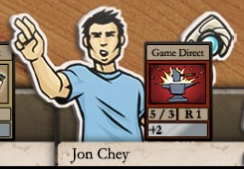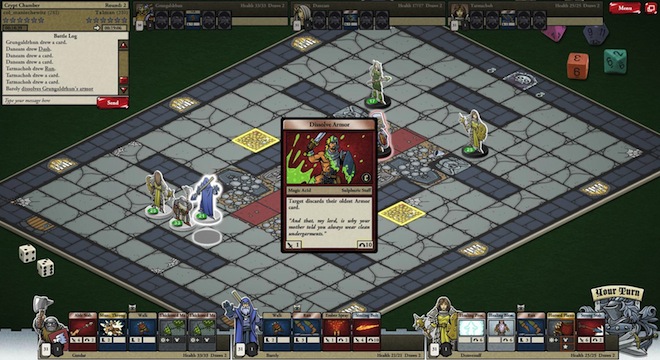The game’s got old-school Dungeons & Dragons trappings, turn-based tactical-strategy gameplay, and treasures (and rare loot) to find. And you don’t need to pay a dime for it.
What else does a developer have to do to win gamers over? Perhaps charge people $60 to play? No, seriously.
Independent developer Blue Manchu recently released Card Hunter (PC, Mac) to positive reviews (like ours). But it still has a strange obstacle to overcome for more widespread acceptance: its lack of a price tag. Traditional economic models be damned — gamers just don’t seem to respect free to play (F2P). And in this day and age!
We interviewed Blue Manchu’s Jon Chey — “the guy who pays the bills” if you ask him, and managing director to everyone else — to learn more about this fascinating phenomenon. Why isn’t this business model working out for all game makers? Why are gamers resistant to try out something that’s free? And how can developers win over suspicious customers?
GamesBeat: What do you think exactly is the problem that gamers have with free-to-play? Joe McDonagh, the cofounder of Blue Manchu, even mentioned seeing some “hostility.”
 Jon Chey: I think gamers are worried that free-to-play models are sucking the life out of gaming — that all games in the future are going to be replaced by rapacious grind-fests that drag you in and then squeeze every last cent out of you as you try to get through them. That their play experience will be ruined by constant in-your-face pressure to spend money. You know, that sort of thing.
Jon Chey: I think gamers are worried that free-to-play models are sucking the life out of gaming — that all games in the future are going to be replaced by rapacious grind-fests that drag you in and then squeeze every last cent out of you as you try to get through them. That their play experience will be ruined by constant in-your-face pressure to spend money. You know, that sort of thing.
We tend to get a lot of comments on our forums and other places where we interact with our audience expressing those [types of] thoughts.
The good thing, though, is that having been through a lengthy beta where players have been able to test out the game and see how the monetization system works, we now have a pretty large group of players who can speak directly to the issue. Instead of us having to leap and say, “Oh, don’t worry — our game isn’t like that,” we can let other players do the talking for us. That tends to assuage fears a lot better than anything we could do or say.
For example, I saw a tweet this morning from someone saying how much fun they were having and then a reply from one of their followers saying, “Damn, I think you’ve convinced me to try a free-to-play game!”
GamesBeat: What’s the worst feedback you’ve ever read?
Chey: “Looks interesting, but I’m not going to try it.” That’s a real kick in the guts every time I see it, given that the reason we made it free-to-play was to try to get people to play it. Would more people try it if it cost $20 to get in? I guess we’ll never know.
GamesBeat: Who do you think is guilty of perpetuating the negative stigma, gamers or developers?
Chey: Interesting question. Who do you blame for drug addiction, the addict or the dealer? Developers created the product, but gamers played — and paid.
GamesBeat: How do you convince these people to check out your game? Or is that a lost cause?
Chey: I guess for those players, it’s more important for us to focus on the gameplay side rather than the monetization side: that is, for us to pitch our message around what the game is rather than the free-to-play aspect. More “Hey, come try this new card-game, board-game, RPG mash-up (oh, and by the way, it’s free-to-play)” and less “PLAY NOW, MY LORD! FREE FOREVER!”
But ultimately, it’s going to be very hard for us to convince people who are suspicious of the free-to-play model to try the game. If you suspect that a game is designed to trap you into spending money or wasting your time, you’re unlikely to believe assurances to the contrary from the game maker.
GamesBeat: Do you think the problem is more with free-to-play, with browser gaming, or both equally?
Chey: I think free-to-play is the big bugbear right now. Browser games are a relatively small segment of the market and easy to ignore if you don’t care for them, whereas free-to-play models have been taking over and converting some much loved franchises.
GamesBeat: Such as?
Chey: In the recent past, I’d say Plants vs. Zombies and Ultima are both good examples. In both cases [publisher Electronic Arts] took a franchise that wasn’t free-to-play and turned it into one. Those are interesting cases, though, because I think the results are very different in each.
GamesBeat: Do you think EA did a good job with those conversions or no?
Chey: I haven’t played a lot of the new Ultima, but I think PVZ2 is a very commendable effort to turn a pay-upfront game into a free-to-play title. I personally would have preferred if it had been left in the original format, but given a mandate to make the conversion, I can’t imagine doing a better job.
GamesBeat: Pretend for a moment that you aren’t making games for a living. Would you agree or empathize with this backlash? Or would you see yourself embracing free-to-play?
Chey: Oh, I do agree [with the backlash]. There are very few free-to-play games that I like, and in general, I am highly suspicious of them.
On the other hand, I’ve played a bunch of them that I like and want to support. For example, World of Tanks is a great game that I’ve poured hundreds of hours into. Compare that to Team Fortress 2, which was my go-to online shooter before WOT. I always felt vaguely guilty that I’d paid once for TF2 and then played it for months after that. With WOT, I’m quite happy to keep chipping in a bit of money here and there because the game is fundamentally good, they provide a continuous online service that I know costs money to run, and they keep expanding and adding to the game. It’s good value for me and makes sense for them as a business.
GamesBeat: What steps have you taken for Card Hunter to assuage any fears or concerns?
Chey: OK, No. 1 is that we started by designing what we thought would be a great game. We didn’t start with a monetization model, as many advised me to, and then build a game around that. Our goal was to create value and then figure out how to get compensated for that.
No. 2 is that we envisage people who want to pay playing the game a lot. We don’t see it is a dead-end grind — we envisage adding more content and keeping the game alive for those who like it.
No. 3 is that we know the core single-player campaign, which is entirely free and is balanced so that you can get through it without paying and without tedious grinding, because we and plenty of our beta testers have played through it that way.
No. 4 is that we’ve just added a single-purchase option to the game, the “Basic Edition,” that unlocks all the remaining single-player content — all of which are optional side-quests — as well as adding a bunch of cosmetic figures, a subscription to the Card Hunter “Club,” and a bit of in-game currency for $25. It’s effectively buying the single-player game if you want more than is available for free.
Finally, I should say that we went to great lengths to ensure that the multiplayer game isn’t pay-to-win, either. Many, perhaps even most, of our top-ranked players in the beta have never paid a cent for the game.
VentureBeat's mission is to be a digital town square for technical decision-makers to gain knowledge about transformative enterprise technology and transact. Learn More



